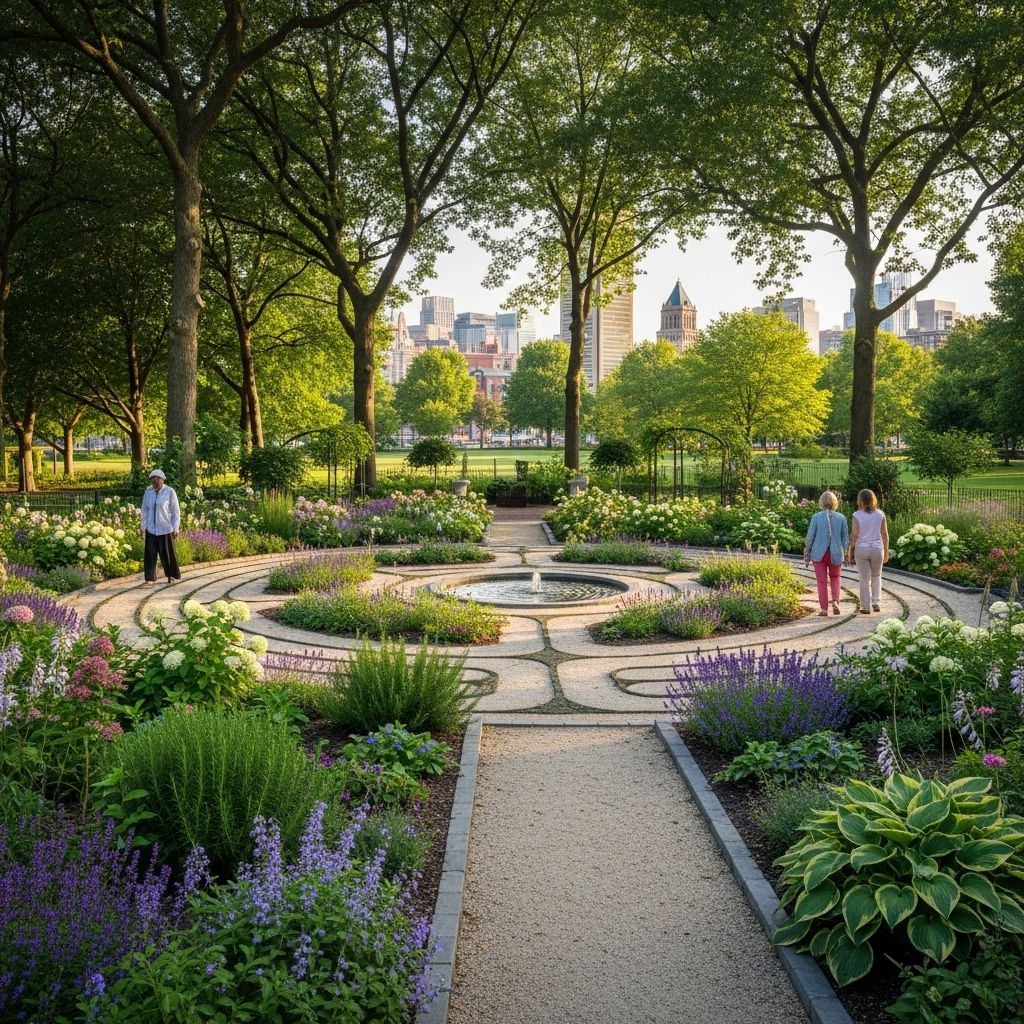Labyrinth Garden Benefits: 5 Healing Powers In Baltimore
Explore how a labyrinth garden blends history, design, and the healing power of walking meditation in the heart of Baltimore.

Image: HearthJunction Design Team
Baltimore’s Garden Labyrinth: Where History and Healing Intertwine
Amid the bustling cityscape of Baltimore lies a tranquil oasis: a garden labyrinth designed for contemplation, restoration, and communion with the self. This sacred spiral has become a destination for residents and visitors alike, offering a unique landscape experience that bridges ancient tradition and modern wellness. In this article, we explore the inspiration, construction, benefits, and symbolism of Baltimore’s labyrinth, along with practical insights for those seeking to create or walk their own labyrinth journey.
The Labyrinth as Sacred Pathway
Despite being an ancient motif found across multiple cultures, the labyrinth is often misunderstood. Unlike a maze, which is designed to bewilder and confound with dead ends and false turns, a labyrinth follows a single, meandering path leading with certainty to a central goal. In gardens like Baltimore’s, this path is not just a physical route but a metaphorical journey inward—a walking meditation that soothes the mind and energizes the spirit.
Labyrinths Through the Ages
- Labyrinths have been discovered in ancient Greek, Roman, and Native American cultures, often incorporated into sacred sites.
- Medieval labyrinths adorned European cathedrals, most famously Chartres Cathedral in France, symbolizing pilgrimage and spiritual quest.
- Today, garden labyrinths are found worldwide, redesigned for therapeutic, educational, and recreational uses in public and private spaces.
Inspiration for Baltimore’s Labyrinth
The garden labyrinth in Baltimore was inspired by the universal appeal of labyrinths as places of healing and wholeness. The vision for its creation emerged from a desire to provide a public space where individuals could escape urban stress and engage with nature in a meaningful, restorative way. Its placement and design draw upon both classical and modern influences to serve as a sanctuary for contemplation.
The Influence of Sacred Geometry
Labyrinths are celebrated for their sacred geometry—the spirals, circles, and symbolic numbers embedded in their layout. These patterns are believed to evoke a sense of balance and harmony, fostering a spiritual connection for those who walk the path. The most common designs include:
- Classical Labyrinths: Typically feature seven circuits, echoing the number of chakras or visible planets.
- Medieval Labyrinths: Often incorporate 11 circuits with a central circle and four quadrants, symbolizing a spiritual journey of transformation.
Designing the Baltimore Labyrinth
The Baltimore labyrinth was designed with careful attention to site, materials, and user experience. Each element was selected to reinforce the journey’s transformative potential, creating not only a visual centerpiece but an interactive work of landscape art.
Key Elements of the Labyrinth
- Pathways: The labyrinth features a continuous, winding path crafted from natural stones and bordered by lush plantings. The path is wide enough for comfortable walking but narrow enough to focus the mind.
- Centerpiece: At the heart of the labyrinth sits a modest stone boulder, inviting walkers to pause, reflect, and absorb the serenity of arrival.
- Heart Space Entrance: A small water feature greets visitors at the entrance, symbolizing purification and marking the threshold between the outer world and the labyrinth’s inner realm.
- Plantings: Fragrant herbs and perennial flowers line the paths, stimulating the senses while offering visual interest throughout the seasons.
Adapting the Space
Given Baltimore’s unique landscape challenges, such as sloping ground, the construction involved grading and retaining walls to create a flat, accessible area. Steps from the upper garden lead down to the labyrinth, seamlessly integrating the feature into its surroundings.
The Walk: Ritual, Reflection, and Healing
Walking the labyrinth is far more than a stroll—it is a moving meditation, a form of ritual that invites personal reflection and emotional healing. The act of following the winding path, with its rhythmic left-to-right and right-to-left turns, helps participants shift out of ordinary consciousness and into a more centered, contemplative state.
Benefits of Walking the Labyrinth
- Reduces stress and anxiety by calming the nervous system and encouraging deep, mindful breathing.
- Improves balance and coordination through stimulation of the inner ear and cross-lateral movement.
- Enhances mental clarity and creativity by allowing the mind to wander freely as the body follows the path.
- Supports emotional healing by providing a safe, nonjudgmental space for working through grief, loss, or life transitions.
- Promotes a sense of spiritual connection and inner peace, regardless of religious or cultural background.
Scientific Perspective
Emerging research indicates that labyrinth walks can measurably lower blood pressure, decrease chronic pain, and improve sleep quality. The repetitive motion of walking curves and turns is thought to have therapeutic effects comparable to gentle physical exercise, while also balancing the brain’s hemispheric activity.
Symbolism and Spiritual Meaning
Beyond its physical design, the Baltimore labyrinth holds deep symbolic meaning. Its circular, spiraling path represents the cycle of life, growth, and rebirth. The journey to the center and back out again mirrors the process of transformation—leaving behind old patterns, discovering insight, and returning renewed.
Numerology and Labyrinth Design
- Seven Circuits: In classical labyrinths, this number relates to the seven planets, chakras, or musical notes.
- Eleven Circuits: Found in Gothic patterns, often linked to spiritual awakening and initiation.
- Four Quadrants: Signify the elements, seasons, or cardinal directions.
- Six-Petaled Flower: At the central goal, symbolizing harmony and balance.
Creating Your Own Labyrinth Garden
The appeal of labyrinth gardening extends far beyond Baltimore. With some creativity and planning, anyone can bring the meditative magic of a labyrinth into their own home landscape.
Steps to Build a Labyrinth
- Choose Your Site: Select an open, level area that offers privacy and tranquility. Consider sun exposure and drainage needs.
- Pick a Design: Classical seven-circuit or medieval 11-circuit patterns are popular, but you can also design a custom path.
- Mark the Path: Use rope, chalk, or hose to lay out the design before installing pavers, stones, or plant borders.
- Plant the Edges: Herbs like rosemary, lavender, or sage provide fragrance and beauty, while stones offer structure and durability.
- Add a Centerpiece: Consider a water element, small tree, or sculpture to mark the goal and create a focal point.
- Personal Touches: Include benches, boulders, or symbolic objects at the start and center for reflection and rest.
Planting for Beauty and Function
Integrating herbs and flowers into your labyrinth not only delights the senses, but also supports pollinators and allows for harvesting fresh botanicals for culinary or medicinal use.
- Mediterranean Herbs: Rosemary, lavender, sage, oregano—ideal for dry, sunny paths.
- Ornamental Borders: Agave, lemongrass, comfrey for texture and structure.
- Water Features: Fountains or ponds add life and reflect light, attracting beneficial insects.
Labyrinths in Community and Culture
Labyrinth gardens are increasingly popular in public parks, hospitals, and educational settings. They foster community by offering a space for group meditation, ceremonies, or simply quiet connection with nature. In Baltimore, the labyrinth has become a cherished urban sanctuary, hosting everything from solitary strolls to guided events.
Finding a Labyrinth Near You
Interested in experiencing a labyrinth walk? The World Wide Labyrinth Locator is an online resource for finding public labyrinths in your area.
Frequently Asked Questions
What is the difference between a labyrinth and a maze?
A maze is a puzzle with multiple paths and dead ends, designed to confuse. A labyrinth has a single, non-branching path that leads to the center and back out again, fostering meditation, not confusion.
How long does it take to walk a labyrinth?
Most garden labyrinths take between 10 and 30 minutes to walk, depending on size and pace. The emphasis is on mindful movement, not speed.
Do I need any special preparation to walk a labyrinth?
No special preparation is needed. Comfortable shoes and an open mind are all that’s required. Some people like to bring an intention or question to contemplate.
Can labyrinths be used for healing?
Yes. Studies and anecdotal evidence suggest that labyrinth walking can reduce stress, ease chronic pain, and promote emotional well-being.
How do I create a labyrinth in a small garden?
Even a modest yard can accommodate a simple spiral or classical labyrinth. Use stepping stones or plant borders to define the path, and scale down the number of circuits as needed.
Conclusion: The Enduring Magic of the Labyrinth
Baltimore’s garden labyrinth stands as a testament to the enduring human need for sanctuary, reflection, and growth. Whether built in a public park or a private backyard, labyrinths invite us to pause, breathe, and reconnect—with nature, with community, and with ourselves. As you next walk a labyrinth’s winding path, remember that every step is both a journey outward and a return to your own center.
References
- https://www.dabahdesigns.com/nj-landscape-design-blog/2017/8/28/garden-labyrinths
- https://chadwickarboretum.osu.edu/our-gardens/lane-avenue-gardens/labyrinth-garden
- https://planetschooling.com/how-to-make-a-labyrinth-garden/
- https://thegardendiaries.blog/2013/02/09/a-healing-labyrinth-part-1/
- https://www.motherearthliving.com/gardening/discover-the-healing-power-of-labyrinths-zm0z19mazpop/
Read full bio of Srija Burman












